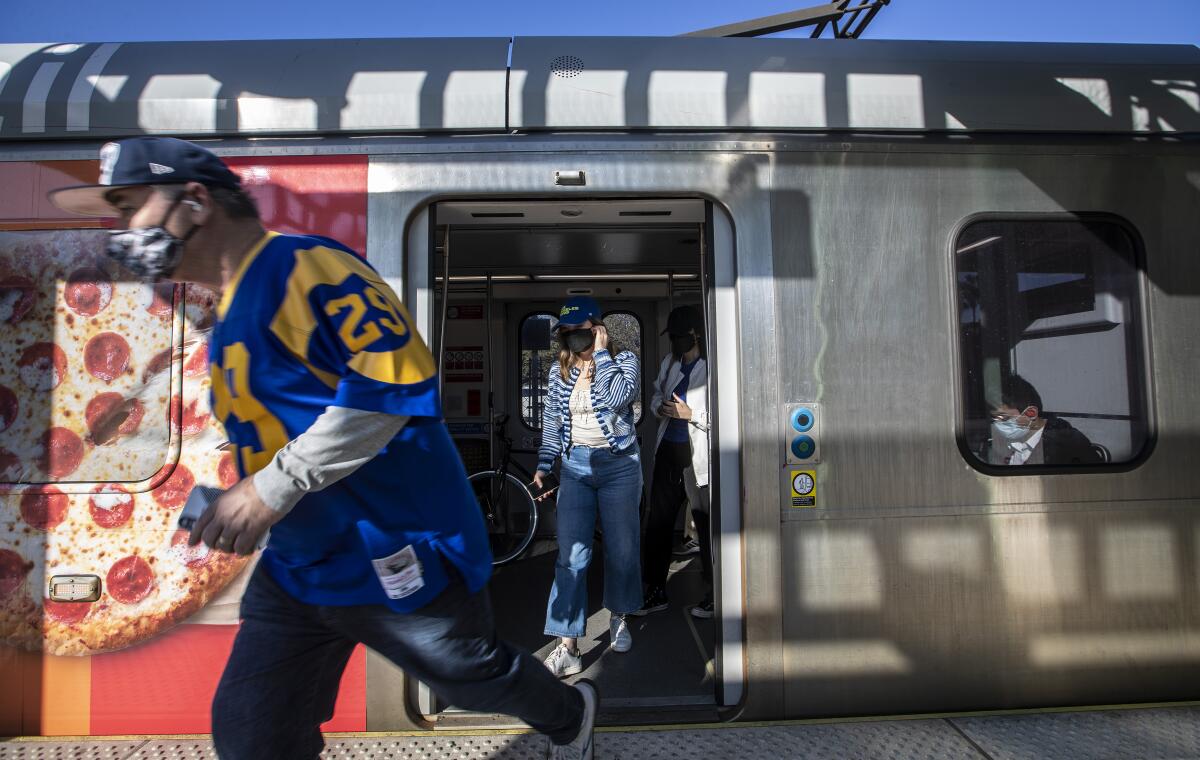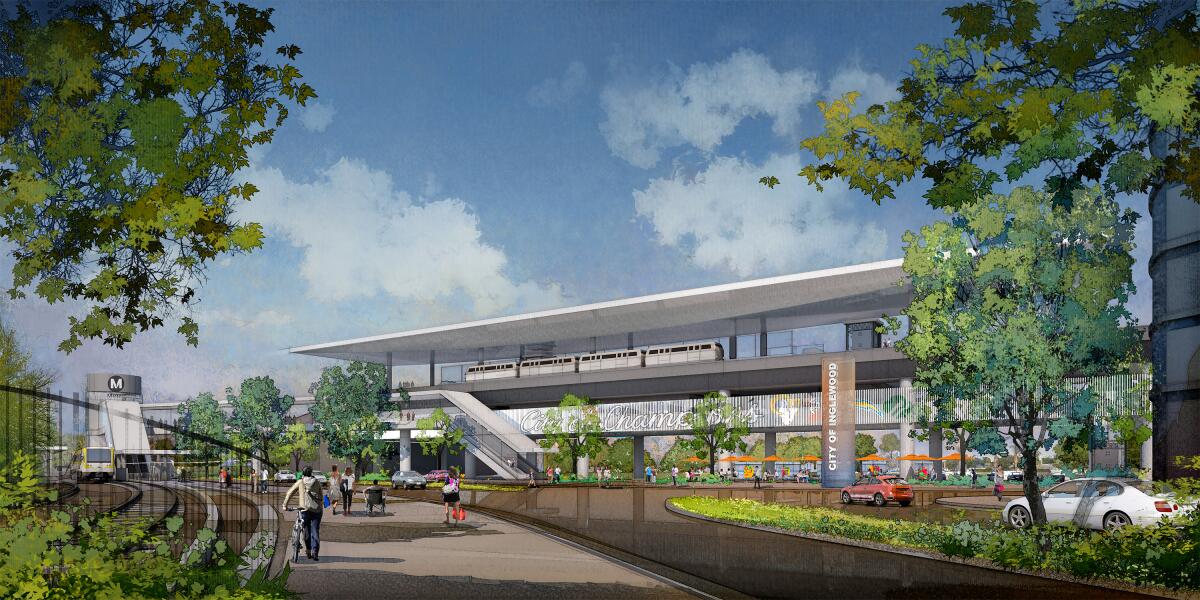People mover, new bike paths and bus lanes: 2028 Olympics could fuel a transit boom in L.A.

A new $1.4-billion electric people mover above the streets of Inglewood would whisk spectators past the Forum to the 2028 Summer Olympics opening ceremony at SoFi Stadium. Across the region, miles of new bike paths, more bus lanes and new bike shares would emerge.
If planners and political leaders can pull it off, spectators of the 2028 Olympics would experience a very different Los Angeles from the one traffic-weary commuters know today, one that would endure long past the Games.
Organizers want the more than a million spectators expected to come to the region for the 17-day Olympiad to eschew cars and arrive at venues by public transit, on foot or by bike. That’s a tall order for a sprawling city famous for its freeways, smog and congestion. And it’s likely to require billions of dollars to fill gaps in the public transportation system.
Los Angeles County’s Metropolitan Transportation Authority is already on a construction building blitz with a subway extension to the Westside, a light-rail line in South Los Angeles and an underground connector linking multiple rail lines beneath downtown. But if the Olympic transportation planners are to meet their goals, more projects are likely to be needed to see a significant shift away from cars.
“Can we achieve the vision? We think we can,” said Ernesto Chaves, who has been leading the Metropolitan Transportation Authority’s efforts to prepare plans for the Olympics.
Olympic organizers are still in the process of creating a transportation plan. But with federal and state authorities spending record amounts on projects resulting from President Biden’s $1-trillion infrastructure law, local planners have a number of proposals for the Olympics.
A Metro task force has identified more than 200 projects that could help support the Games: a people mover in Inglewood , an extension of the C Line (formerly the Green line) from Redondo Beach Station to Torrance, a rail line through the East San Fernando Valley, a cybersecurity update on Metro’s system, new protected bike lanes across the region and more bike-sharing programs.
Many of the projects were already on the books, but weren’t fully funded or were years or even decades out. Other proposals include adding restrooms at Metro stations, increasing bus service and paying people to not drive their cars during the Games.

If anything, the Olympics brings an urgency — a 2028 deadline — to goose legislators to speed up a laborious process. “We may be leveraging the Olympic Games,” said U.S. Sen. Alex Padilla (D-Calif.). “But this is all infrastructure investment. That will benefit the region for years and years and years to come.”
Not all those projects will make the cut. As it is, LA28, the private committee responsible for staging the Games, has predicted it will cost $6.9 billion without any infrastructure improvements. And big projects tied to the Olympics have been controversial, forcing some host cities — including Tokyo in 2021 and Rio de Janeiro in 2016 — to run up massive deficits.
The task force — working with LA28, the city of Los Angeles and other transportation agencies — will decide on a list of transit projects by the end of the year, which will be used to go after available federal and state funding dollars.
This week, Padilla introduced legislation that would allow the U.S. Department of Transportation to give Olympic projects priority grant funding and help with planning, capital and other resources. Rep. Julia Brownley (D-Westlake Village) introduced similar legislation in the House last month.
“The city of Los Angeles, the state of California and the United States will be in in the spotlight when the Olympic Games in 2028 take place. So it’s not just a point of national pride, but the whole country has an interest in it,” Padilla said.
Both bills, which LA28 helped guide, would allow the Department of Transportation to fund temporary facilities, equipment, operations and maintenance. It might also fund additional buses and even the people mover.
Similar legislation to leverage money from the federal government was passed for the 2002 Olympic Games in Salt Lake City.
Olympic organizers say the L.A. Games bid does not require new transportation infrastructure, but they welcome it if it would improve the city in the long run.
“If the Olympics coming can be a catalyst to accelerate things that are sort of in the line, we’re all for it,” said Casey Wasserman, the chair of LA28. “But we don’t want to be the reason and the only reason it comes.”
Infrastructure is often one of the biggest considerations for the International Olympic Committee when it picks a host city. While Los Angeles won its bid without promises of massive capital projects like new arenas, local officials want to build up an infrastructure that the world would see and serve the region for decades to come.
Critics have raised questions about the federal government committing billions of dollars to the city.
“Why should senators from the other 49 states want to divert more money to California just because California is hosting the Olympic Games?” asked Andrew Zimbalist, an economist at Smith College in Massachusetts and frequent critic of the Olympic movement.
“The U.S. government is already going to be footing 90% or more of the security bill, which is probably going to be $2 billion. And that’s generally understood to be the extent of their involvement, but it’s a pretty large involvement.”
Watch L.A. Times Today at 7 p.m. on Spectrum News 1 on Channel 1 or live stream on the Spectrum News App. Palos Verdes Peninsula and Orange County viewers can watch on Cox Systems on channel 99.
The idea of accelerating projects that otherwise might stand in a queue for years started shortly after Los Angeles was awarded the Olympic bid. At the time, Mayor Eric Garcetti announced “28 for 2028,” a list of transportation projects — most already in the works — to be completed before the Olympic flame is lit. The subway extension, the light-rail tunnel and the subway connector, as well as a bike path along the L.A. River, were part of that 28.
Those projects are now on the task force’s list, which has dozens of smaller projects near what are expected to be key venues, such as SoFi Stadium, UCLA and the Rose Bowl.
Organizers still must come up with logistical plans to move thousands of athletes through the region to dozens of venues via an Olympic fleet.
Chaves said the biggest advantage organizers have is the technology to see real-time traffic and the sheer growth of the transportation system. When Los Angeles hosted the 1984 Olympics there were no subway or rail lines running through the city. Freeways were still being built. Nonetheless, planners managed to ease traffic with more buses, shifting deliveries to nighttime and encouraging flexible work schedules.
Padilla, who watched the 1984 Olympics as a child from his family’s home in Pacoima, never got to see the Games up close. But he said, he is sometimes still reminded of it while in traffic.
“I remember the license plates,” he said. “If you look hard enough, there’s some people that still pride themselves on the special edition commemorative license plates.”
More to Read
Sign up for Essential California
The most important California stories and recommendations in your inbox every morning.
You may occasionally receive promotional content from the Los Angeles Times.











